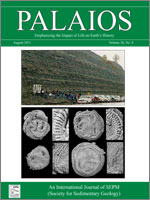The Cambrian–Ordovician boundary interval is a critical moment in the ecology of trilobite communities. To understand this transition, we studied—at three different spatial scales—changes in the structure of olenid-dominated communities included in the Parabolina fauna, which flourished in the latest Cambrian, largely storm-dominated, successions of northwestern Argentina. At the local (∼meter) scale, species-poor communities occur in shoreface deposits. Relatively flat species-abundance distributions (SADs) and high evenness characterize upper offshore to offshore transition settings of the early highstand systems tract (HST), whereas uneven SADs in species-poor communities are typical of the lower offshore and shelf environments of the transgressive systems tract (TST). This pattern is unlikely to be caused by a change in time averaging and is consistent with the intermediate disturbance hypothesis predicting unimodal diversity gradients. The pattern is thus interpreted to be related to a trend in intensity and frequency of storm disturbance along local shallowing-upward gradients. At the regional scale (∼100 km), the diversity trend across the sampled west-east transect is rather variable and does not match the depth or oxygen-related gradients. At the biogeographic scale, the patterns of abundance of two key taxa (Parabolina and Asaphellus) show contrasting abundance and occupancy patterns between the Cordillera Oriental siliciclastic settings and the more carbonate-rich settings of Famatina (Argentina) and Oaxaca (Mexico). The presence of these genera in settings spatially adjacent, but environmentally different from their preferred habitats can represent a signature of source-sink dynamics. Low sample evenness values for the Cordillera Oriental contrast with those of coeval Laurentian communities, implying that a secular increase in evenness took place earlier in Laurentia than in Gondwana.
How to translate text using browser tools
1 August 2011
PALEOECOLOGICAL DYNAMICS OF FURONGIAN (LATE CAMBRIAN) TRILOBITE-DOMINATED COMMUNITIES FROM NORTHWESTERN ARGENTINA
DIEGO BALSEIRO,
BEATRIZ G. WAISFELD,
N. EMILIO VACCARI
ACCESS THE FULL ARTICLE
It is not available for individual sale.
This article is only available to subscribers.
It is not available for individual sale.
It is not available for individual sale.

PALAIOS
Vol. 26 • No. 8
August 2011
Vol. 26 • No. 8
August 2011




